Then suddenly in December 2008, life turned ugly for Weiner. Just two months into his new job as executive vice president, chief marketing officer of Domino’s, his wife forwarded him a meme, which was floating freely on the internet. “We make our pizzas and our boxes out of the same material," read the caustic message, which displayed two boxes of Domino’s. One was open and showed a pizza, and the other one was closed. Weiner didn’t know how to react. “Three months after I joined Domino’s, the stock hit a new low of under $3," he recalls in an exclusive interview with Forbes India on his maiden visit to India as CEO in the third week of December. The new innings had nothing to smile, and say cheese!
Rewind to his decade-long stint at Pepsi, Weiner was indeed more than happy. For the marketing maverick, life was fun. He crafted Pepsi’s largest promotion in history—“Stuff"—a continuity programme rolled out to retain core Pepsi users, and his Diet Pepsi MAX ad campaign won an Effie Award for “Wake up People" in 2008. The same year, he was Brandweek"s Top 10 Marketers of the Next Generation, and was also Advertising Age Top 40 under 40. The icing on the cake was Pepsi’s 2008 Super Bowl ad featuring Justin Timberlake, which emerged as the number one Super Bowl ad viewed online. Clearly, Lady Luck was smiling.
Fast forward to December 2008, Weiner’s luck was in shreds. Domino’s was into its third year of consecutive negative same store sales: 4.1 percent, 1.7 percent and 4.9 percent in 2006, 2007 and 2008, respectively. The celebrated marketer soon realised that the new brand he started working for had lost its fizz. The adjectives that the marketer passionately clung to all his life—invigorating, uplifting, exciting and fun—suddenly deserted him. And it was not a happy realisation at all.
Outside the panel too, the reaction swung from outrageous to scandalous. “Boring, bland, artificial imitation of what pizza can be, mass-produced, worst excuse for pizza I had ever had…" Weiner felt the tension, and it was piling up every day, every moment. Though a leader in pizza delivery, Domino’s menu was perceived as staid, and was struggling to stay relevant compared to rivals Pizza Hut and Papa John’s.
![]()
It was a war-like situation and Domino’s was ceding ground at an alarming pace. The CMO then decided to don the war colours. “We blew up the bridge," says Weiner, alluding to airing a spate of self-deprecating commercials towards the end of 2009, which honestly acknowledged the shabby quality of pizza. “To go on air and say our pizzas are not good was really risky," he recalls. What made the gambit look even more outrageous was the precarious position of the brand. “The stock was under $3," he adds. Critics were out with knives, and branded him mad.
![]()
There was, though, a method in Weiner’s madness. His team took two long years to work on new recipes, which upgraded the crust, sauce, and cheese. The CMO led from the front in reinventing Domino’s, and was confident that the new product was much better than the original one. The realisation made him blow up the bridge. “If you ever read The Art of War," he remarked during one of his interviews in 2010, “they say the best way to win a war, if the war is fought on an island, is to blow up the bridge." There was no retreat from the new product, and positioning, which was rolled out in the last week of 2009.
![]()
The move to make the brand naked was inspired by what consumers were feeling back in 2008-09. America, and the world, was in the midst of a gruelling recession. Consumers, Weiner underlines, were looking for honesty and transparency. The public’s trust in the government, banks, and a clutch of big corporations had waned alarmingly, and people were asking hard-hitting questions. Domino’s decided to give some answers. The mea culpa ads were supported by a money-back guarantee on the pizza, and the brand fanned out in the country trying to woo consumers with the new product. “We went to the doors of people who hated us, and requested them to taste the new product," he says in a free-wheeling conversation.
Pizza turnaround & storytelling
The gambit worked. Honesty and the new product paid off. From a 0.5 percent growth in same store sales in 2009, the numbers pole-vaulted to 9.9 percent in 2010. From a low 9 percent share of the pizza restaurant market in 2009, the slice expanded to 15 percent in 2016. From being a laggard in the US market, Domino’s went on to become the biggest. Global retail sales zoomed from $7 billion in 2011 to a staggering $17.8 billion in 2021. The beauty of the brand, interestingly, is that it has managed to keep the crown and increase the lead. (See box)
![]() Weiner, though, is quick to add one more ingredient that went into making the secret sauce: A powerful storytelling. One of the things, he underlines, the restaurant industry doesn’t do well is they don"t really tell stories. If one closes their eyes, and thinks of a fast food ad, it would be ‘here"s the new product’, ‘now it"s got extra this’ and ‘here"s the price point’, and maybe a silly joke. “What we try to do at Domino"s is tell stories about how we"re trying to get better as a pizza company," says Weiner, who was in India to roll out 20-minute delivery service by the pizza giant, which is now the biggest in the world.
Weiner, though, is quick to add one more ingredient that went into making the secret sauce: A powerful storytelling. One of the things, he underlines, the restaurant industry doesn’t do well is they don"t really tell stories. If one closes their eyes, and thinks of a fast food ad, it would be ‘here"s the new product’, ‘now it"s got extra this’ and ‘here"s the price point’, and maybe a silly joke. “What we try to do at Domino"s is tell stories about how we"re trying to get better as a pizza company," says Weiner, who was in India to roll out 20-minute delivery service by the pizza giant, which is now the biggest in the world.
But can a 20-minute delivery tell a different story than the original 30-minute, which nailed the game for Domino’s? The CEO dons a marketer’s hat to answer the question. “We have always been the delivery experts," says Weiner. Delivery, as it has turned out over the last few years, especially in a post-pandemic world, is nothing unique. Every F&B player and food brand is delivering. “As a delivery expert, we have to get better," he says, justifying the move to raise the bar. “If anyone can deliver faster than us, then we"re not the experts anymore," he smiles.
Interestingly, the proliferation of outlets in India has led to crunching the delivery time. Weiner explains. Back in 2009, India ranked sixth in terms of outlets. Mexico was the biggest country outside the US with 589 outlets India, in contrast, had 296. Fast forward to 2022. India tops the chart with 1,625 outlets (1,701 in Q2 FY23). Mexico, in contrast, has a tally of 813. The UK, Japan and Australia follow India in the pecking order. “The only reason we can get the pizza faster to our customers is because our stores are closer," he says. Weiner is quick to allay fears about fast driving. When you have stores that are closer to customers, he underlines, it"s not about how fast you drive. “We have speed governors on all the vehicles, and so drivers can"t drive fast," he says.
Meanwhile, back in the US, Domino’s is struggling to get enough drivers. To add to the woes, there is a looming threat of recession, an unprecedented level of inflation, and a possible resurgence of an almost-waning pandemic. All combined have taken a toll on the performance. In the first quarter of this year, US recorded same-store sales decline of 3.6 percent. The headwinds included an Omicron surge, staffing shortages and rising prices. There was no respite in the second quarter. The US same-store sales declined by 2.9 percent on the back of a difficult labour market. Though Q3 brought cheer in terms of rebound in same-store sales, staffing remains a constraint.
![]()
Poker & the best hand
Can the CMO-turned-CEO produce another magical spell, and come out of the storm valiantly? Weiner prefers to draw inspiration from two track records. First, he joined Domino’s in 2008, a year of economic stress and tension, and managed to grow the brand over the next decade. Second is the performance of the brand. “We delivered around one out of every three pizzas in the United States before the pandemic, and we deliver around one out of every three pieces today," he remarked in a Q3 earnings call in October this year. As we begin Q4, he underlined in his analysts’ call, Domino"s is poised to emerge from these volatile times stronger than ever. “This is what our business model was built for," he added.
![]() The challenges remain, though. A high rate of inflation will impact delivery. “Our research shows that relatively higher delivery costs might lead some customers to prepare meals at home," he acknowledged in the earnings call. Weiner, though, was quick to weave in a positive story of hope. “In a world where consumer confidence is shrinking and inflation is high, Domino"s will succeed," he remarked, dishing out his reasons. First, the brand has managed to build strong profitable franchisees. Second, the team makes disciplined decisions based on insight. And lastly, he claims Domino’s has the digital supply chain and delivery expertise to offer best-in-class value and customer experience.
The challenges remain, though. A high rate of inflation will impact delivery. “Our research shows that relatively higher delivery costs might lead some customers to prepare meals at home," he acknowledged in the earnings call. Weiner, though, was quick to weave in a positive story of hope. “In a world where consumer confidence is shrinking and inflation is high, Domino"s will succeed," he remarked, dishing out his reasons. First, the brand has managed to build strong profitable franchisees. Second, the team makes disciplined decisions based on insight. And lastly, he claims Domino’s has the digital supply chain and delivery expertise to offer best-in-class value and customer experience.
Back in India, Weiner talks about an equation loaded in the favour of the brand. The customer-value equation, he explains, has a numerator and a denominator. While the numerator is the benefits the brand gives to the customer, the denominator is what the brand charges. “We"re always at the best value," he contends. But what about the onset of a recession, which will lead to a drastic cut in discretionary spends? Weiner flashes out a card analogy to underline his point. In a poker game, he reckons, as long as the cards are fair and same for everybody, the best poker player wins. “No doubt, there are going to be headwinds. But when I think about us and our competition, we"re the best poker players," he signs off.

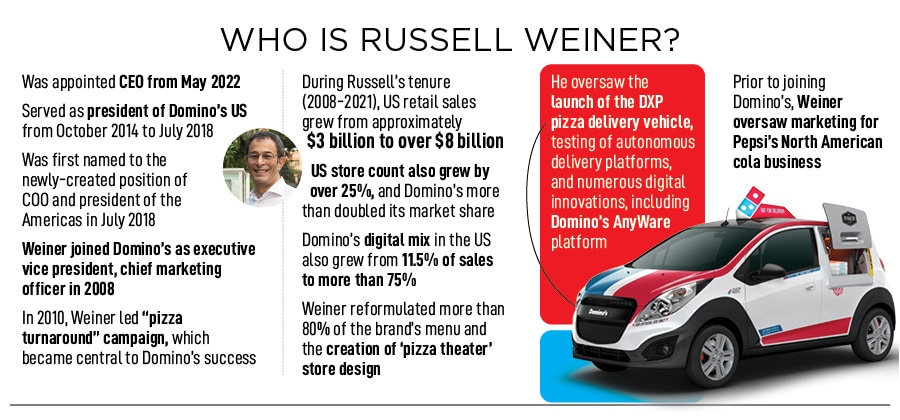

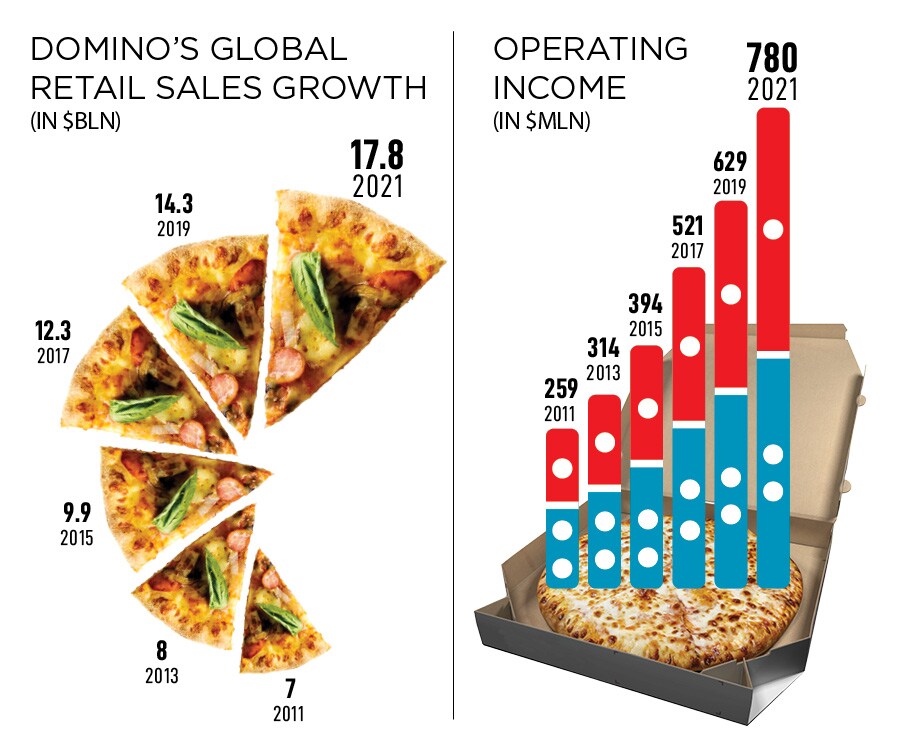

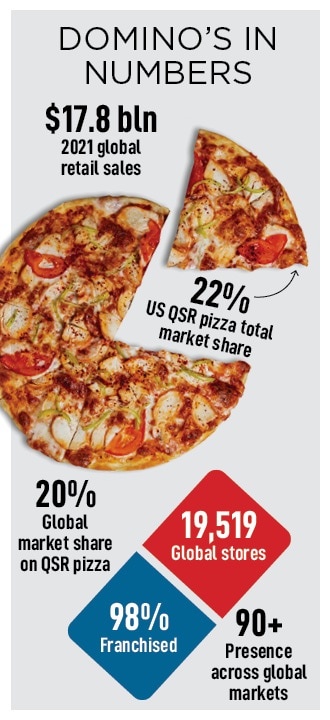 Weiner, though, is quick to add one more ingredient that went into making the secret sauce: A powerful storytelling. One of the things, he underlines, the restaurant industry doesn’t do well is they don"t really tell stories. If one closes their eyes, and thinks of a fast food ad, it would be ‘here"s the new product’, ‘now it"s got extra this’ and ‘here"s the price point’, and maybe a silly joke. “What we try to do at Domino"s is tell stories about how we"re trying to get better as a pizza company," says Weiner, who was in India to roll out 20-minute delivery service by the pizza giant, which is now the biggest in the world.
Weiner, though, is quick to add one more ingredient that went into making the secret sauce: A powerful storytelling. One of the things, he underlines, the restaurant industry doesn’t do well is they don"t really tell stories. If one closes their eyes, and thinks of a fast food ad, it would be ‘here"s the new product’, ‘now it"s got extra this’ and ‘here"s the price point’, and maybe a silly joke. “What we try to do at Domino"s is tell stories about how we"re trying to get better as a pizza company," says Weiner, who was in India to roll out 20-minute delivery service by the pizza giant, which is now the biggest in the world.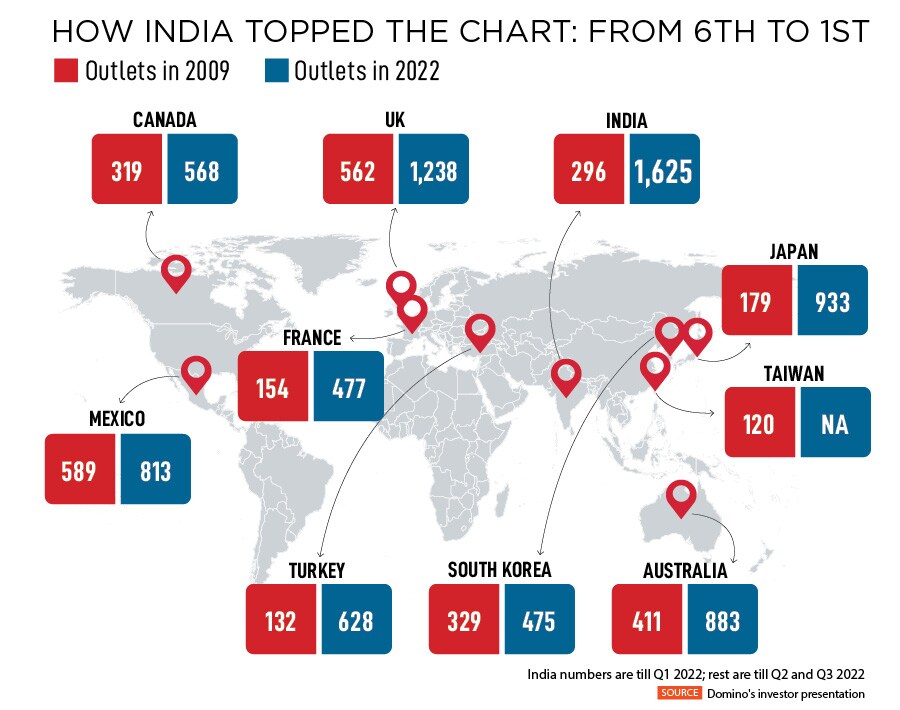
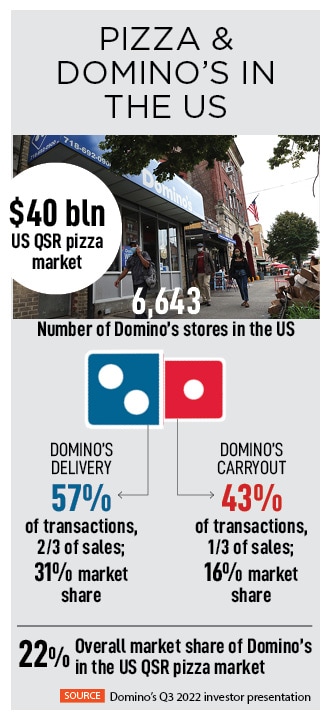 The challenges remain, though. A high rate of inflation will impact delivery. “Our research shows that relatively higher delivery costs might lead some customers to prepare meals at home," he acknowledged in the earnings call. Weiner, though, was quick to weave in a positive story of hope. “In a world where consumer confidence is shrinking and inflation is high, Domino"s will succeed," he remarked, dishing out his reasons. First, the brand has managed to build strong profitable franchisees. Second, the team makes disciplined decisions based on insight. And lastly, he claims Domino’s has the digital supply chain and delivery expertise to offer best-in-class value and customer experience.
The challenges remain, though. A high rate of inflation will impact delivery. “Our research shows that relatively higher delivery costs might lead some customers to prepare meals at home," he acknowledged in the earnings call. Weiner, though, was quick to weave in a positive story of hope. “In a world where consumer confidence is shrinking and inflation is high, Domino"s will succeed," he remarked, dishing out his reasons. First, the brand has managed to build strong profitable franchisees. Second, the team makes disciplined decisions based on insight. And lastly, he claims Domino’s has the digital supply chain and delivery expertise to offer best-in-class value and customer experience.